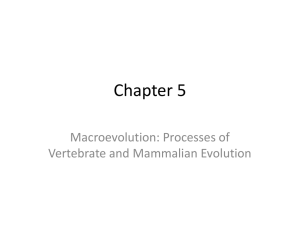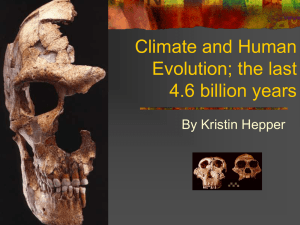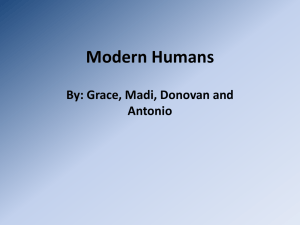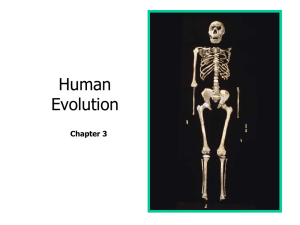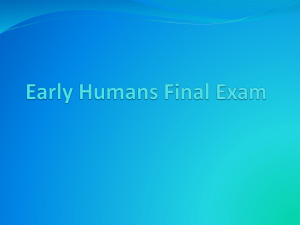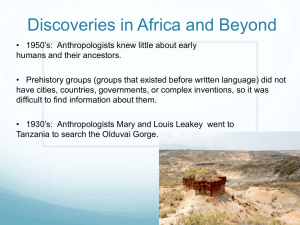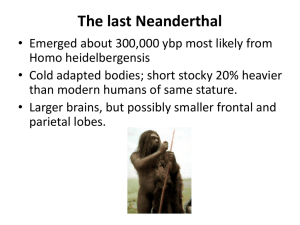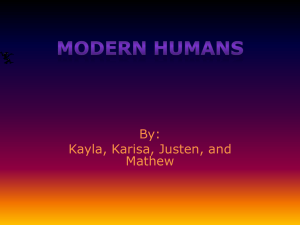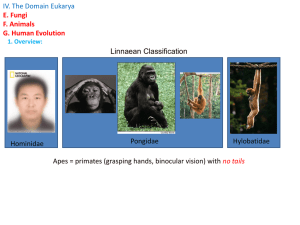Human Evolution
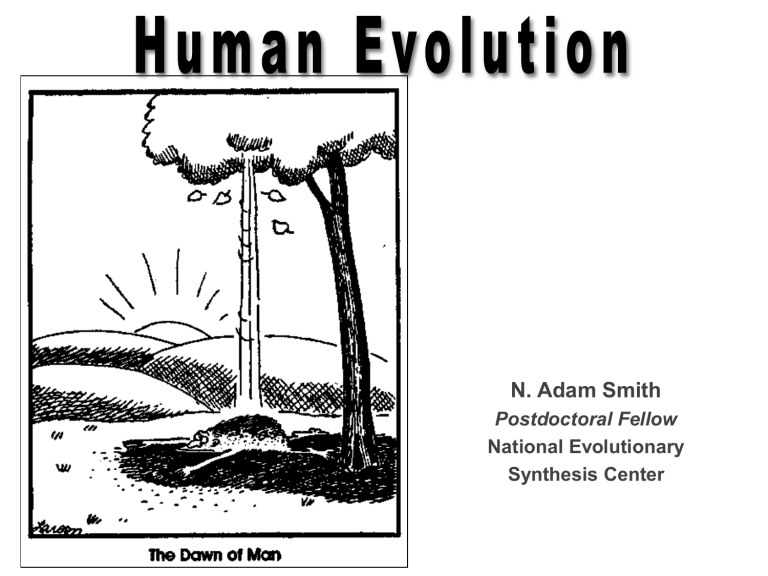
N. Adam Smith
Postdoctoral Fellow
National Evolutionary
Synthesis Center
Who are the closest living relatives of humans? How do we know?
Bonobo Chimp Gorilla Orang
Where are they now?
Orangs
Chimps
Gorillas
Bonobos
Early evidence: immunology
Mitochondrial gene phylogeny
• Primates evolved from a small tree dwelling mammal.
• Dental evidence from fossils suggests that primates descended from insectivores in the late Cretaceous (~65 mya)
• Oldest known primate-
Purgatorius unio (~63 mya)
Earliest Ancestors
Plesiadapis: 60 mya
one of the oldest known primate
-like mammal species
Mainly lived on the ground
However, it was a good climber.
It was an arboreal quadruped.
It was a tree-moving, 4-legged animal.
What was the selective pressure for our ancestors to evolve?
What happened about 65 mya?
Why were they more fit than dinosaurs in the changing environment?
Primate Characteristics
rounded heads
flat faces
large brain (cerebrum)
forward facing eyes, binocular vision
flexible shoulders and hips
for brachiation
opposable thumb: thumb can cross the palm to meet other fingertips
Extant
Primate
Phylogenetic
Relationships
Prosimians
small, nocturnal, large eyes
Found in Africa and Southeast Asia
Includes lemurs, tarsiers, and bush babies
fruit & insect eating
Evolved from common ancestor 50-55 million years ago
Anthropoids
Includes humans, apes, and most monkeys
Means “humanlike primates”
Split into three major branches
Old World Monkeys
New World Monkeys
Hominoids
New World Monkeys
Central and South
America
Tree-dwelling, prehensile
(grasping) tails
Squirrel monkeys
Spider monkeys
Old World
Monkeys
Africa and Asia
Langurs and
Macaques
No tails, much bigger
Hominoids: Great Apes
Hominoids
Great apes: Include orangutans, baboons, gorillas, chimpanzees, and humans
Non-humans found in Africa and Asia
Chimps and humans share 98% of their
DNA (~50% with flies and bananas; ~75% with dogs)
Hominoid Characteristics
Bigger, stronger than monkeys, no tails
Diastema: gap between canine teeth (lost in modern humans)
Sagittal crests: “fin” on the skull that is a point of attachment for jaw muscles (lost in modern humans)
Sexual dimorphism: difference between males and females
Hominini or hominins
(i.e., humans and close ancestors)
Branched from other hominoids 6-7 mya
Larger brains (cerebrum)
Bipedal locomotion (walk upright on 2 feet)
More advanced hands and opposable thumbs
No sagittal crest: allows for bigger brains!
No diastema
Earliest Hominins
(extinct hominids)
• Ardipithecus
• Australopithecus
• Paranthropus
• Homo
Ardipithecus
• Earliest ancestor from other primates,
6-4 mya
• Found in Africa
• Somewhat bipedal
• Small stature, small brains
• Reduced sexual dimorphism
• Four named species
• “Ardi” from Eastern Africa, 4.4 mya
Australopithecus
• 4.4-2.1 mya
• Human and “ape-like” characteristics
• Bipedal, but still had long arms
• Small brains (1/3 size of modern humans)
• 4 named species
• “Lucy”, A. afarensis
Australopithecis afarensis
Human
Footprints
1978 Mary Leakey discovered footprints in
Laetoli from A. aferensis (3.75 mya)
Paranthropus
• 3-1 mya
• Large teeth, powerful jaws
• Prominent sagittal crest
• Found throughout Africa
• Shows some increase in cranial capacity over time
Genus Homo
• 2.2 mya – present
• First group to expand beyond Africa
• Large brains, used tools
• First to be exclusively bipedal
• 7 named species, only 1 still extant
Genus Homo
• Homo habilis 2.4-1.4 mya
• Homo rudolfensis 1.9-1.8 mya
• Homo erectus 1.89 m – 143,000
– First to leave Africa, upright, used axes
• Homo heidelbergensis 700,000-200,000
– Europe, Asia, Africa
• Homo neanderthalensis 200,000-28,000
– Europe and Asia
• Homo floresiensis (“Hobbit”) 95,000-
17,000
– Tiny people, 3 ft. 6 in.
Ancient Humans
Homo habilis (“handy man”)
2.5 mya, used tools, big brains
Homo erectus
Walked upright, probably migrated from
Africa
Homo habilis
Tool Making
~Modern Humans
Homo neanderthalensis
200-30 kya
Found in Europe and Western Asia
Homo sapiens
100 kya in Middle East and Europe
35,000 years ago H. neanderthalensis disappeared and H. sapiens evolved into modern humans: Homo sapiens sapiens
Neanderthal cave drawings
Deliberate
Burials
Homo sapiens
Archaic – 100,000 to 35,000 years BP
Modern – 35,000 years BP to present
Anatomically modern
Sometimes called Homo sapiens sapiens
Brain Cavity Size
Homo sapiens
Homo erectus
Homo habilis
Australopithecus africanus chimpanzee
Modern Human Regional Variation
African European-SW Asian East Asian Australian
• milk leg - pregnant woman have arteries to legs pinched
• hemorrhoidsveins more vulnerable to congestion, impedes blood flow to lower intestine and anal sphincter
• foot problems - too small to bear body wt.
• learning to walkchildren learn to walk gradually and changes in the body structure must accompany the learning process
• wisdom teeth - jaws are small and too many teeth
• childbirth - birth canal small, heads large
• back problems - curvature of back poses strain, more vulnerable to injury
• hernias - upright posture puts more strain
• varicose veins - return of blood to heart puts strain on veins
Out – of – Africa Theory
Modern humans evolved relatively recently in Africa, migrated into Eurasia and replaced all populations which had descended from Homo erectus.
- after Homo erectus migrated out of Africa, the different populations became reproductively isolated, evolving independently , and in some cases like the Neanderthals, into separate species
Homo sapiens arose in one place, probably Africa (geographically this includes the Middle East)
- Homo sapiens ultimately migrated out of Africa and replaced all other human populations, without interbreeding
- modern human variation is a relatively recent phenomenon
We know this is true because every single human being across the planet has the same innate and learned behavior skill set.
We can also interbreed successfully with humans across the planet.

